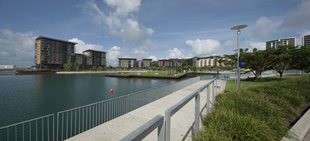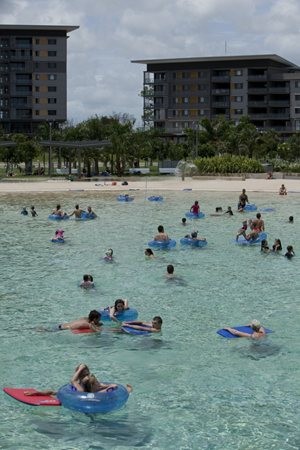Matthew Pullinger is a principal, architect and urban designer with Hassell.
In 2005, Pullinger led the Hassell design team that was successful in winning the Northern Territory Government’s $1.6b Darwin City Waterfront redevelopment project. Stage 1 of the project has recently been completed and includes the Darwin Convention Centre, extensive public parklands, a hotel and mixed-use residential development comprising 138 apartments.
He is also NSW president of the Australian Institute of Architects.
Architecture & Design spoke to Pullinger about his work in Darwin, why he would change 1 Blight Street and three key features all masterplans need to have.
You were involved with the Darwin City Waterfront development. Can you tell A&D about your role and the approach you took?
As a part of a project team at Hassell, my involvement began with a successful competition proposal for the remaking of Darwin's industrial port and its reinstatement as the front door to the city. Over several years we had the rare privilege of reconnecting the city with the water and creating a truly inclusive public parkland at the water's edge.
There were also residential, commercial, hotel and convention centre projects, but it is the public realm that stitches these elements together and gives character and quality to the place. Locals and visitors alike come to enjoy the tropical waterfront setting and the renewed connection with the harbour. Creating a truly democratic public place with uninterrupted access to the water’s edge was a fundamental design principle. Prior to this project, there were too few public places that connected the people of Darwin to the foreshore.
 Darwin Waterfront, above and below. Photography: Brett Boardman
Darwin Waterfront, above and below. Photography: Brett Boardman
What is Darwin's typical approach to design?
Darwin presents a beguiling enigma. As Australia's tropical capital city, a place with a profoundly Asian character and a highly transient population, it still has many of the qualities of a frontier city. Great opportunities are presented to people very early in their careers. At the same time, the city's position atop an escarpment often limits its engagement with the harbour setting. And finally, Darwin’s climate is extreme for many months of the year, despite also enjoying a beautiful, benign dry season. These factors are all at play in the best of Darwin's design.

The best Darwin buildings are highly attuned to this ever-present climate - feathered, lightweight, elevated and low in thermal mass. At the same time, any post-Tracy project has had to address some of the most demanding, inflexible building codes in Australia. Cyclone proofing, storm surge protection, aggressive termite and insect attack and 100 per cent humidity for months on end all take their toll on a building's fabric and expression.
The perpetual challenge is to satisfy contemporary building codes but also embody the spirit of an outdoor lifestyle during the 'dry', while accommodating the need for respite during the 'wet'. Some buildings do this superbly and elegantly. However, many do not, instead importing generic construction techniques and inappropriate spatial planning from the southern states. A willingness to adapt traditional design and planning to contemporary design challenges is essential.

What are the top three things which you think all masterplans should consider?
Designing in the public realm brings with it great breadth and scope, but also great complexity and a responsibility to serve interests well beyond those of the immediate client group. That’s not to say that these interests are inherently mutually exclusive. The challenge is often in finding alignment between seemingly incompatible perspectives.
There are three things that all good master plans have in common:
1. An intelligent attitude to increasing urban density in a manner that is respectful of an existing context, culture and history, but which also brings with it greater amenity. We must continually work to shift the perception that as urban density increases, quality of life diminishes. My view is firmly to the contrary.
2. The integration of transport choices. Sustainable cities must incorporate as many viable modes of transport as possible and should prioritise public transport convenience ahead of private modes. The balance should favour the pedestrian over other modes in order to make places civilised, amenable and urbane. Cars should be accommodated on terms that do not compromise the pedestrian.
3. The inclusion of mixed-use spaces. Diversity, richness and vitality in the best cities follows from the careful arrangement of complementary uses in a manner that creates delight and a reason to linger in public space.
You have worked in the public sector on urban design projects. What were some important things you learnt in the public sector which have helped you in the private sector?
I benefited enormously from spending five years in the NSW Department of Planning and its Urban Design Advisory Service. It was here that I had an opportunity to develop a far-reaching piece of design policy in State Environmental Planning Policy (SEPP) 65, which mandates the involvement of a registered architect in the design of all residential apartment buildings in NSW.
Ten years on, the SEPP has proven to be an incredibly successful policy that has directly lifted community expectations for design quality in the built environment and placed architects at the centre of the solution of increased density and delivery of great design.
Applying this experience to the private sector, I can say that working in the government gave me a strong ethic in advocating for the public interest, which I now apply to all my projects. It also helped me helped me understand the importance of genuinely engaging people, and made me better able to achieve consensus in complex, layered projects. Urban design, like all cities and all democracies, is as much a political art as it is a creative one.
How do you define what is 'good design'?
Good design is elusive and often fleeting. The best design often goes unnoticed, and perversely, it is poor design which is more obvious and distracts us from our daily routine. I am drawn to the notion that good design is, in part, invisible. It serves its purpose well, doesn't remind you of its shortcomings, and it avoids overstatement for deeper reading and greater subtlety in execution.
Of course for those of us with design training or a sense for quality, these objects and buildings also lift the human spirit and bring delight to the beholder.
What is one building you wish you had designed and why?
The original finger wharves of Walsh Bay in Sydney for their understated elegance, restraint and mastery of materials, coarse utility, authenticity, direct detailing and great longevity. Most importantly, they are an indelible emblem of Sydney and its harbour.
What is one building you would want to change in Australia and why?
I think that Australian society generally hasn't yet dealt well with the issue of building height. In the context of our need to embrace urbanisation and the benefits it brings, there are plenty of buildings that could use a few more stories. This would be to eke more out of valuable inner urban land resources, to allow the ongoing renewal of the city, our greatest resource, and also to improve these buildings' slenderness and silhouette. Because 1 Bligh Street in Sydney is as good as it is, I wish it were about half as tall again!

